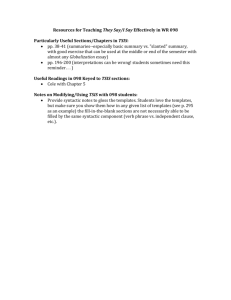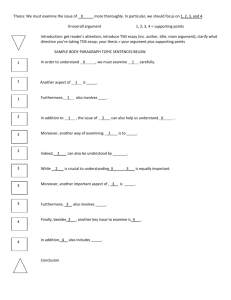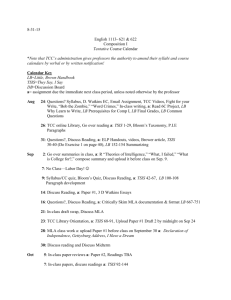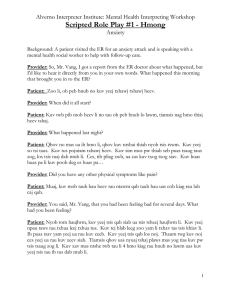Chatterjee_ESL Workshop Presentation
advertisement
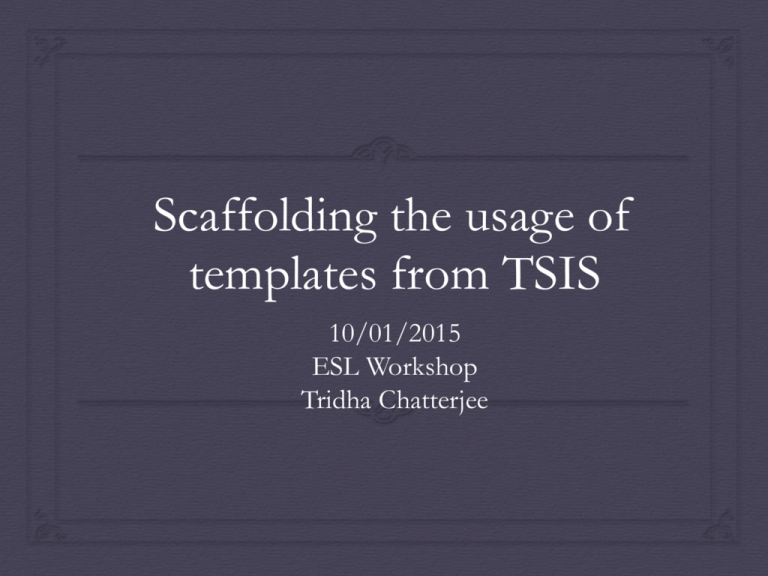
Scaffolding the usage of templates from TSIS 10/01/2015 ESL Workshop Tridha Chatterjee Some questions to consider TSIS provides several handy and concrete templates for students to make use of Although the book is not aimed specifically towards ESL students As instructors we can guide ESL students in a way that the templates in the book become more useful to them What type of exercises can we design keeping this aim in view? Can we provide more context to the templates so that students understand them better? Ideas to explore Illustrate for students how different authors use some of the templates suggested by TSIS This will highlight that the templates suggested in the book are really useful and in fact are often used by established authors Understand how using the templates make the texts/articles much more accessible. Using articles from the Globalization Reader to illustrate these points An example Boroditsky’s “How Does Our Language Shape The Way We Think” Scholars on the other side of the debate don't find the differences in how people talk convincing. All our linguistic utterances are sparse, encoding only a small part of the information we have available. Just because English speakers don't include the same information in their verbs that Russian and Turkish speakers do doesn't mean that English speakers aren't paying attention to the same things; all it means is that they're not talking about them. It's possible that everyone thinks the same way, notices the same things, but just talks differently. Believers in cross-linguistic differences counter that everyone does not pay attention to the same things: if everyone did, one might think it would be easy to learn to speak other languages. Unfortunately, learning a new language (especially one not closely related to those you know) is never easy; it seems to require paying attention to a new set of distinctions. Whether it's distinguishing modes of being in Spanish, evidentiality in Turkish, or aspect in Russian, learning to speak these languages requires something more than just learning vocabulary: it requires paying attention to the right things in the world so that you have the correct information to include in what you say. Templates to introduce an ongoing debate (TSIS Chapter 1) Scholars on the other side of the debate don't find the differences in how people talk convincing. Believers in cross-linguistic differences counter that everyone does not pay attention to the same things. Such a priori arguments about whether or not language shapes thought have gone in circles for centuries, with some arguing that it's impossible for language to shape thought and others arguing that it's impossible for language not to shape thought. Urging students to use the templates in their own writing Considering Boroditsky’s article, several of you agreed that the article was very interesting and well argued. However, you also thought the author put too much emphasis on language and not much on culture. Use the template from TSIS below to express this point. Although I agree with X upto the point that ________, I cannot accept her overriding emphasis on X because I think _______________ Urging students to use the templates in their own writing Considering Polanki’s article, several of you agreed that the NCERT Initiative “Operation Mind Your Language” provided an excellent opportunity for Afghan students to learn English. However, you also wondered if a 20-month program was enough to make the students competent users of the language. Use the template from TSIS below to express this point. I am in two minds about this initiative by X. One the one hand, I agree that _______. On the other hand, I am not sure if _______________. Incorporating TSIS into lectures Quotations: Purpose What is the purpose of quoting? Gives credibility to your writing Shows you are well-informed about a text What are some mistakes authors make when it comes to quoting? Quoting too much or too little Not providing enough commentary to a quote TSIS Chap 3 Quotations: How to use them? Quotes should be used strategically to support ones arguments Quotes need to be framed within the larger discourse What is a “dangling” quote What is a “hit-and-run” quote? “Quotation sandwich” Top layer introduces the quote Bottom layer explains it Aim should be to build bridges between the quote and your own interpretation of it TSIS Chap 3 Quotations: Language for introducing quotes? Compare: James Smith asserts that “….” James Smith states that “….” James Smith warns us that “……” James Smith recommends that “……” Verbs such as warns and recommends accurately reflect the mood of the author. TSIS Chap 3 Quotations: How not to introduce them? A quote by Shakespeare says.….. What is the problem with this? Misleading: Its the author who is quoting and not Shakespeare! Orwell asserts an idea that….. What is the problem with this? Redundant: Either say “Orwell asserts that” or “Orwell’s idea is that” TSIS Chap 3 Thank you!
